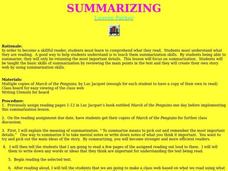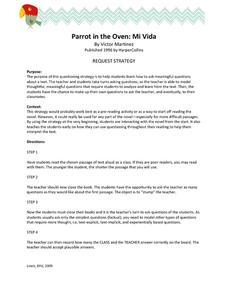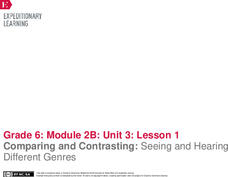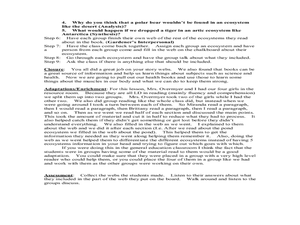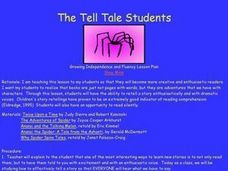Curated OER
Summarizing
Third graders examine how to summarize the most important details in a reading passage in order to increase their comprehension. They design a story web using the summarization skills. Before class, they complete a reading assignment...
Curated OER
Can You See It?
Students discuss how to visualize while reading. They read The Thanksgiving Day Parade and Old Yeller. Students relax and picture their favorite place. They share what they saw and discuss the concept of visualization. Students visualize...
Curated OER
Thumbs Up For Expert Readers!
Students use the cross check strategy to increase reading comprehension in this lesson. They listen as the teacher reads "Where the Wild Things Are." The teacher purposely reads some words wrong so that the story does not make sense. ...
Curated OER
Let's Be Emotion Detectors!
Young scholars observe and demonstrate how to read with expression. They discuss the types of emotions and expressions to use while reading, and identify the appropriate punctuation for a variety of sentences. Students then write a...
Curated OER
Parrot in the Oven: Request Strategy
Victor Martinez's Parrot in the Oven: Mi Vida is used in an activity that models how to develop questions to aid in comprehension of a text.
Curated OER
Guided Imagery: Preparation for Chapter 5 of The Catcher in the Rye
A guided imagery exercise about a favorite person prepares class members for the introduction of Holden Caulfield's brother, in chapter five of J.D. Salinger's famous novel. This focus on Allie emphasizes for readers his importance to...
Curated OER
Shizuko’s Daughter: Story Impression
Craft your own fairy tale based on Momotaro, a Japanese story referenced in Kyoko Mori's Shuzuko's Daughter. A list of nouns guide learners in writing their own story, and predicting what might happen in the novel.
EngageNY
Comparing and Contrasting: Seeing and Hearing Different Genres
Let's compare and contrast! Scholars use a Venn diagram to compare and contrast the experience of reading a poem and listening to its audio version. Next, they complete graphic organizers, comparing two different genres: a poem and a...
Curated OER
Spring-Aloud Read
Students study the season of spring and create stories about the season. In this spring season lesson, students read books about spring and discuss the season. Students then color and create a mini-book about Spring.
Curated OER
Reciprocal Reading
Students practice their reading comprehension skills by making their own bookmark about the books they have read.
Curated OER
We All Need Speed Limits
Students consider fluency and speed of reading. In this speed limits lesson, students discuss the importance of speed when reading and how the rate affects comprehension and listening skills. Teacher models think aloud as a strategy.
Curated OER
Graphic Organizers Aid Comprehension
Students create story webs to aid comprehension of ecosystems. For this reading strategies lesson, students discover the importance of organizing information while reading a nonfiction text. Students produce story webs to communicate...
Curated OER
Anticipatory Set Picture Walk
The teacher models a Picture Walk by using a "think aloud" method while reading a picture book to the class. On the second day, 3rd graders use a worksheet as a guide for a second picture walk. This time, students complete the "think...
Curated OER
Super Duper Summarizer!!!
Third graders review the technique of silent reading and study how to summarize what they read. Next, they examine the five steps to summarize a passage and apply it to a reading of Patricia Nikolina Clark's, "Mr. Pilling's Pond." Using...
Curated OER
Macaroni Quotation Marks
Students practice using quotation marks. In this writing skills lesson, students listen to a story, read quotations aloud, and use macaroni as quotation marks where they are needed in the provided sentences.
Curated OER
The Magic Pot
Students read the story The Magic Pot and complete language arts based activities based on the story. In this language arts lesson plan, students discuss, listen, observe, and complete language worksheets.
Curated OER
Super Summarizers
Students practice summarizing passages which they read silently in order to remember what they read. They follow steps for summarizing by highlighting the important details, removing the less important ones, and retelling they highlights...
Curated OER
Geo Jammin' - Day 2, Lesson 6: Rhyme and Reason
Students listen to the poem "Shapes" by Shel Silverstein in order to accurately and specifically describe shapes' rules/traits in their journals. They illustrate the poem and take turns reading during a creative shared reading session.
Curated OER
If You Don't Believe Me, Look It Up!
Students learn about bats. In this bats and comprehension lesson, students read Stellaluna and share what they know about bats. Students complete a learning log and Internet bat research worksheet.
Curated OER
Travlin' Through the Basin: Guided Imagery
Students listen to a story. In this imagery lesson, students listen to nature sounds of the Everglades, water and forest. Students listen to a reading of the Tangipahoa River guided imagery passage. Students share their feelings inspired...
Curated OER
Listening to Learn: Podcasting as an Assessment Tool
Students use podcasting and iPods to take tests rather than reading. In this podcasting lesson plan, students learn how to use a podcast rather than have a test read to them.
Curated OER
Newbery Books: Guaranteed Good Reading
Sixth graders explore and analyze Newbery Medal books. They view a Powerpoint presentation on the Newbery Medal book of that current year, select a book, read and analyze the book, and prepare a multimedia book report presentation.
Curated OER
The Tell Tale Students
Young scholars practice summarizing text by retelling what they have read. They read selected, leveled passages and use enthusiastic and createive ways to members of their group. Students complete a journal entry documenting their...
Curated OER
Education
In this education dialogue worksheet, young scholars read the dialogue aloud in pairs. Students read through 7 questions and complete online activities.


